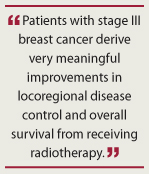Women who have already undergone mastectomy and chemotherapy may question why additional breast cancer treatment is needed. Benjamin D. Smith, MD, of MD Anderson Cancer Center in Houston said that he frequently has patients referred to him who initially express their preference to avoid radiation after mastectomy.
 “Ultimately if a patient makes that decision and is appropriately counseled and educated, I certainly respect that,” Dr. Smith said, “but part of my role as a radiation oncologist is to counsel patients so that they understand the risks and benefits of radiotherapy. I find that the vast majority of rational people, if they are appropriately counseled, will choose to receive radiotherapy. The literature from randomized clinical trials is quite strong, convincing, and corroborated by our own institutional experience, which is that patients with stage III breast cancer derive very meaningful improvements in locoregional disease control and overall survival from receiving radiotherapy. That improvement is on the same order of magnitude as the benefit they receive from chemotherapy or endocrine therapy. So most women aren’t going to undergo a mastectomy, take endocrine therapy, and receive chemotherapy and not finish the course of recommended therapy once they understand what is at stake.”
“Ultimately if a patient makes that decision and is appropriately counseled and educated, I certainly respect that,” Dr. Smith said, “but part of my role as a radiation oncologist is to counsel patients so that they understand the risks and benefits of radiotherapy. I find that the vast majority of rational people, if they are appropriately counseled, will choose to receive radiotherapy. The literature from randomized clinical trials is quite strong, convincing, and corroborated by our own institutional experience, which is that patients with stage III breast cancer derive very meaningful improvements in locoregional disease control and overall survival from receiving radiotherapy. That improvement is on the same order of magnitude as the benefit they receive from chemotherapy or endocrine therapy. So most women aren’t going to undergo a mastectomy, take endocrine therapy, and receive chemotherapy and not finish the course of recommended therapy once they understand what is at stake.”
Good Teamwork
“Reviewing the literature with patients is very helpful,” Dr. Smith said. Also important is establishing and maintaining “good relationships with the other physicians in the multidisciplinary care team,” he continued. For patients going from chemotherapy to radiation therapy and being transferred from the care of one physician to another, having “a good system and a good team working together gives your patients a lot of assurance.”
At MD Anderson, weekly tumor boards and multidisciplinary clinics provide an opportunity for surgeons, medical oncologists, radiation oncologists, and others to discuss “patients with challenging or unusual problems, and to educate one another about new things going on in our fields,” Dr. Smith said. “At the multidisciplinary clinics, we work together to develop a treatment plan for patients… I think we are relatively well-versed in one another’s subspecialties and know when we need to send patients back and forth to one another.” ■

